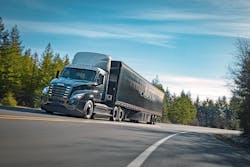Freightliner eCascadia Heavy Truck
After what the company calls “extensive” development and “rigorous” testing, Freightliner has brought its battery electric eCascadia heavy truck to market. The zero-emission truck has multiple battery and drive axle options, providing a typical range of 230 miles with depot-based charging.
Freightliner eCascadia Electric Truck Specs
- Power: 320-470 hp
- Typical range: 230 miles, depending on configuration
- Maximum capacity: 440 kWh
- Recharge, 80 percent: 90 minutes
- Max GCW: 82,000 lb.
Engines, axles, and transmissions on the electric truck are supplied by Detroit, with an in-house developed Detroit ePowertrain designed for a full integration. The eAxle is an electric drivetrain component integrated with an electric motor, transmission, and specialized electronics within a compact unit. Two eAxle designs are available: a dual motor with max torque of 23,000 lb.-ft. and max power of 395 hp, and a single motor with a max torque of 11,500 lb.-ft. and max power of 195 hp.
Three battery options include zero-to-full charging times of 194 kWh (1.5-3 hours), 291 kWh (2-4 hours), and 438 kWh (2-6 hours).
An in-house developed Charger Management System (CMS) is integrated directly into the Detroit Connect portal. CMS provides reports about depot utilization, data for grant compliance, and Low Carbon Fuel Standard credit reporting. CMS allows for staggered charging of multiple vehicles, charging during off-peak-demand hours, and partial charging. CMS is optimized for use with Detroit eFill chargers, and is also compatible with other popular charger models.
The eRange prediction tool automatically and accurately calculates and displays range over the course of a proposed trip. To give the most accurate indication possible, the tool analyzes multiple data inputs including vehicle parameters, load, weather, traffic, and road gradient. eRange Prediction allows for testing of “what-if” scenarios and performs analysis.
Battery health monitoring tracks and gives visibility into the eCascadia battery’s state-of-health percentage, state-of-charge percentage, remaining range miles, and charging status. Post-trip analysis gives actionable information to improve the eCascadia’s performance, utilization, and driver training. Based on actual trip data, users can visualize and quantify operational differences between trips. Outlying data is highlighted so that managers can easily identify exceptional situations.
Freightliner.com
